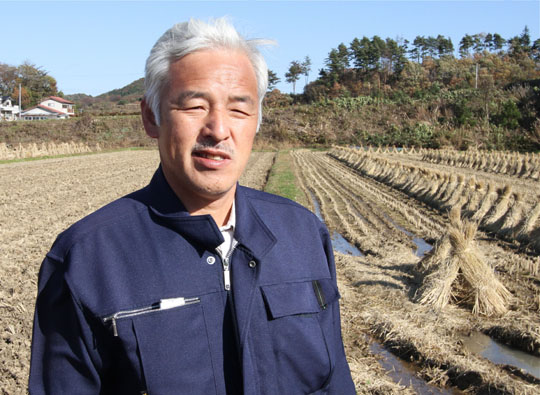MIHARU VILLAGE, Fukushima Prefecture ― As bitter winds blow around
cesium and other radioactive particles spewed from the nearby Fukushima
No. 1 nuclear power plant’s reactors, Naoto Matsumura lights a
cigarette, which he considers relatively good for his health.
“I would get sick if I stopped smoking; I have a lot to worry about,”
says Matsumura, 52, who reckons he is the only person still living
within a 20-km radius of the world’s worst atomic disaster since Chernobyl.
According to reports from Japan’s Nuclear and Industrial Safety Agency
published in August, following the Great East Japan Earthquake on March
11, and subsequent explosions at three reactors about 13 km from
Matsumura’s door, the plant operated by Tokyo Electric Power Co. (Tepco)
has released 168 times more radiation than the atomic bombs that razed
Hiroshima and Nagasaki in 1945.
Living without electricity or enough money to fill his generators with
gas, even as the mercury is already dipping below zero, Matsumura
wonders if his neighbor’s supply of charcoal will be enough to keep him
warm through the frigid winter in his corner of the once-thriving town
of Tomioka that used to be home to 16,000 people.
He’s worried, too, that the hundreds of animals he’s been feeding since
the area’s other residents were evacuated in haste on March 12 ― some
400 cows, 60 pigs, 30 fowl, 10 dogs, more than 100 cats, and an ostrich
― won’t survive to see another spring.
“They need help from humans,” he says while lighting another of the
20-odd cigarettes he admits to smoking a day. “My supplies to feed them
will be gone by the end of December. They need food, and buildings for
shelter from the winter. I’m the only one taking care of everything. The
government should do it, but I’m doing it.”
As we stand in a rice field outside the exclusion zone about 40 km due
west of the ongoing meltdowns, Matsumura tells me that he comes from an
ancestral line of samurai, and he was raised by a “spartan” father to
work hard and think for himself.
A lifelong farmer, he’s lived alone since separating from his wife 10
years ago. When his worried children, aged 23 and 21, called from their
homes in distant Saitama Prefecture after the explosions in March,
Matsumura says he told them: “Don’t worry. If the whole world dies from
this nuclear disaster, I’m still not going to die. I’m not going to
leave here.”
Indeed, this silver-haired, soft-spoken man of the land who has enjoyed
playing golf in Saipan and the Philippines, says he now views himself as
a lone maverick in a toxic desert ― one hunted by an invisible enemy
called “radioactivity” eating away at living things now and into the
future. As the other animals perish around him, he wonders when it will
be his turn.
All Matsumura’s friends have left, and they no longer ask him to bring
their stuff to them in the temporary shelters they must now inhabit. The
automatic vending machines, which used to light up the country roads, no
longer work.
After sunset, he is surrounded by miles of total darkness devoid of
human movement. He has no television or Internet, only a cellphone that
loses charge all too quickly. He stokes up a charcoal fire in his house,
tucks himself into a futon, and goes to sleep by 7 p.m. ― haunted by
nightmares of what could be happening inside his body.
Waking with the rising sun, he eats another can of food, and takes his
dogs for a 20-minute walk among barren fields. He spends daylight hours
cleaning grave sites and tending to animals withering around him in
their stalls, sheds and barns. Meanwhile, cows and pigs and other
animals set free by their fleeing owners in March now fend for
themselves in wild, radiation-contaminated nature.
Even nine months after everybody else fled on March 12, Matsumura says
he is still shocked by the scenes of cruel death he encounters daily:
the bones of cows that starved tied up or in confined spaces after
they’d eaten all their fodder; a locked cage full of 20 shrivelled
canaries denied by their keeper’s panic even a chance to fly away free.
“People don’t want to see dead animals. They would be shocked if they
saw it for themselves. I see it every day,” this animal-lover says
quietly with real feeling.
His efforts to publicize the plight of the animals haven’t worked, he
says. He tells how he once showed a low-level government official around
nearby Tomioka town ― formerly famous for having one of the longest
cherry-blossom tunnels in Japan ― and told him they should at least take
away carcasses. But even though Tepco brings in thousands of workers to
stabilize the reactors, he says the official told him: “Sorry, Mr.
Matsumura, we can’t do anything inside the 20-km evacuation zone.”
On April 21, more than a month after the ongoing disaster began,
Matsumura joined a protest outside Tepco’s headquarters in Tokyo. “I
told them, ‘Take care of the pets and farm animals, it’s your
responsibility.’ But they only said, ‘We are studying it.’ They still
haven’t taken action,” he reported.
In September, he showed two lower-level Tepco officials around Tomioka.
During their conversation together, he says, “I told them to tell the
top people about what they saw. Maybe they told them, but the top guys
pretend they don’t know anything,” he said, pausing to light a
cigarette. “They don’t have human hearts. They only think about money.”
Though he’s not alone in lambasting Tepco, Matsumura’s rage is more
intense than most. He blames Tepco for “killing” his 100-year-old aunt,
who he says died from exhaustion after being moved from several
hospitals between Tomioka and finally Aizu-Wakamatsu in western
Fukushima Prefecture.
He says Tepco, which will need massive taxpayer funding to stay afloat,
has only paid nuclear refugees \1 million each in compensation (about
$12,000).
Yet the company, which claims to be on schedule with its plan to achieve
a cold shutdown of the damaged reactors by the new year, saw fit to
present itself in a positive light when, on Nov. 12, it invited 35
journalists (including four from overseas) for a first media view of its
wrecked nuclear plant.
“I think it’s remarkable that we’ve come this far,” Environment Minister
Goshi Hosono told those on the tour. “The situation at the beginning was
extremely severe. At least we can say we have overcome the worst.”
Such hints of hubris, however, sit uneasily with the established facts.
In November, the esteemed journal Proceedings of the U.S. National
Academy of Sciences carried the results of an international research
study led by Teppei Yasunari of the Universities Space Research
Association in Maryland. This found that radioactive cesium had
“strongly contaminated” the soils in “large areas” of eastern and
northeastern Japan, including Fukushima Prefecture, while western Japan
had been relatively sheltered by mountain ranges. (To view this report,
visit www.pnas.org/content/108/49/19530.)
Since the release of those findings, the Tokyo government has recently
banned the sale of rice from large swaths of Fukushima Prefecture after
high levels of cesium were found in crops from Onami, about 65 km
northwest of the nuclear power plants.
Though Matsumura, who doesn’t have a geiger counter, says he somehow
thinks radiation levels are decreasing, he believes it’s not safe for
former residents to return to Tomioka. And he’s adamant that children
shouldn’t eat rice from eastern Fukushima Prefecture, though he does
himself.
Parking his white Suzuki truck near Koriyama City train station outside
the evacuation zone, he says that his plight and that of the animals in
his locality is not widely known in Japan ― largely, he riles, because
TV companies have ignored him or repeatedly canceled segments about him.
“It’s now impossible for me to meet with Japan’s mainstream media,” he
explains. “If I say bad things about Tepco, and the government, they
won’t run it because Tepco is their sponsor.”
One tabloid magazine, Friday, did run a two-page feature on Matsumura,
with bizarre photos of him feeding an ostrich ― which it quipped in bad
taste was “the official mascot of Tepco.”
So, as he believes himself to have been ostracized in his native Japan,
Matsumura has made a few trips to Tokyo to beg foreign journalists to
tell the truth about Fukushima. To reach him inside the no-entry
evacuation zone, one such from Italy walked along railway tracks for 20
km under cover of darkness to evade police patrols. Searching for him,
as their meeting was prearranged, Matsumura says he could hear the man’s
footsteps in a pitch-black railway tunnel. “When he was about 10 meters
away, I called out ghost noises ― and he was dumbstruck with fear. He
later told me he’d thought his heart was about to explode.”
Another visit Matsumura received recently was on a Sunday afternoon in
November. The farmer tells how an ambulance suddenly showed up at his
door. “I was a bit unnerved that they’d come into my house, and I didn’t
know who’d sent them,” he said, adding that “they checked my body and my
health, but they didn’t find anything bad in particular.”
He gets most passionate talking about the abandoned animals and about
nuclear energy. “The whole world should stop using this bad form of
energy. Anything we build with our hands can break someday,” he says.
“Governments should stop lying to us. Everybody in Fukushima ― everybody
― doesn’t believe the news about the nuclear situation.”
As he prepares to leave me at the station and return to his home in the
no-go zone before night falls, he says that Tomioka, like other towns in
the evacuation zone, will disappear unless drastic action is taken
immediately.
As he put it: “Only senior citizens are saying they want to move back,
not the younger people. Eventually, in 20 years, all these elders will
pass away, and there won’t be any younger generation to maintain the
circle of life. Nobody will be left.”
But for now, he says, he’s going to stay. “I am not bored or depressed,
because I’m used to being alone. I know I am doing the right thing. My
own doctor says I’m a ‘champion of radiation.’ ”
By CHRISTOPHER JOHNSON
Special to The Japan Times





